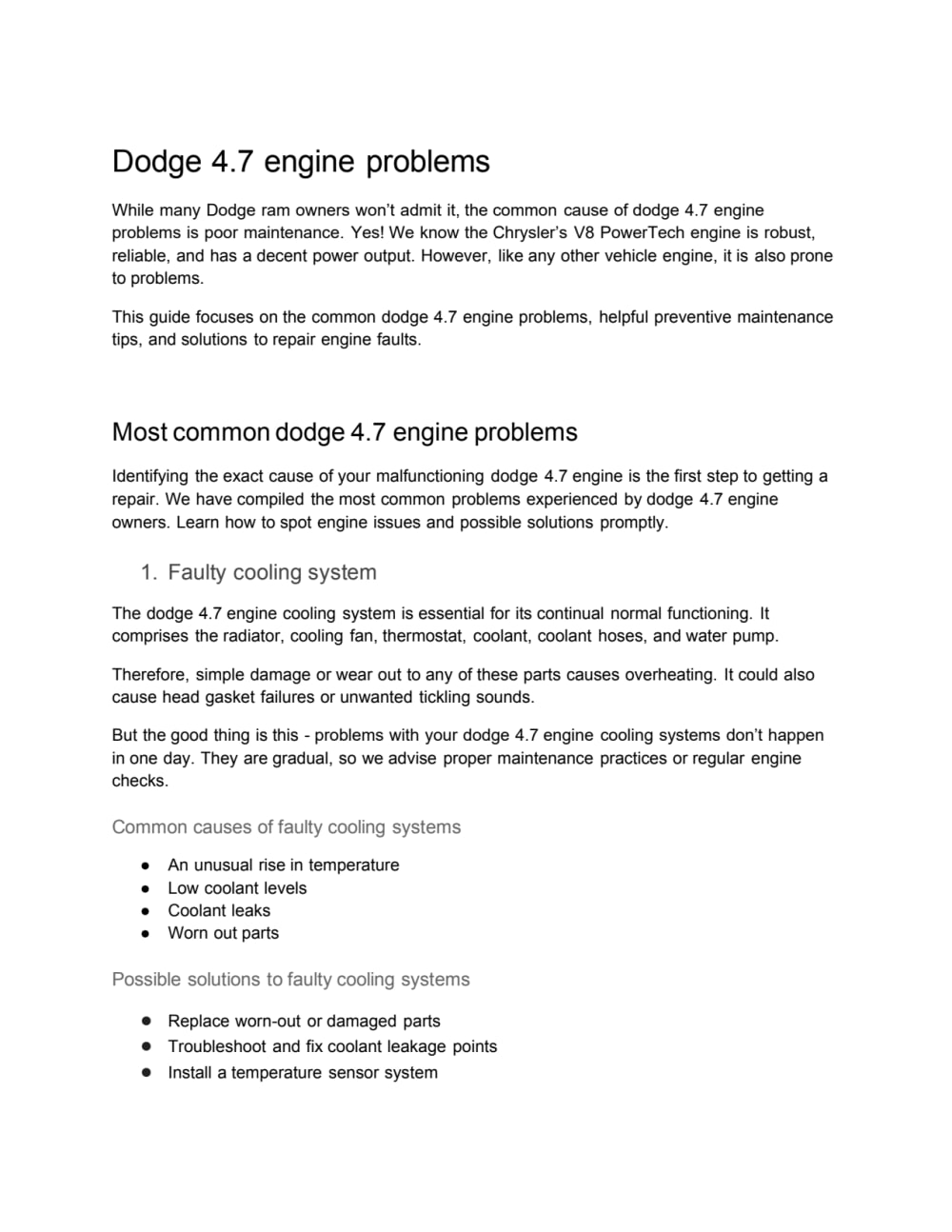Effective Solutions for Radiator Overheating Issues
Effective solutions for radiator overheating issues include regular maintenance, proper coolant levels, checking for leaks, and servicing the cooling system as needed. These steps will help prevent overheating and ensure optimal radiator performance.
Is your vehicle’s radiator constantly overheating, causing you stress and frustration? Don’t worry, there are effective solutions to tackle this issue head-on. By implementing a few simple maintenance practices and being proactive, you can avoid overheating problems and keep your radiator running smoothly.
We will discuss some essential tips and tricks that will help you resolve radiator overheating problems effectively. With a little bit of care and attention, you can keep your vehicle’s cooling system in top shape and avoid costly repairs down the line. So, let’s dive into these solutions and say goodbye to radiator overheating issues for good.

Credit: www.upwork.com
Common Causes Of Radiator Overheating
Common Causes of Radiator Overheating:
Low Coolant Levels
Insufficient coolant can lead to overheating as it is vital for regulating temperature.
Thermostat Malfunction
The thermostat controls the flow of coolant; a malfunction can cause overheating.
Radiator Blockages
Blockages in the radiator can impede coolant flow resulting in overheating.

Credit: m.facebook.com
Signs Of Radiator Overheating
Radiator overheating is a common issue that many car owners face, which can lead to serious engine problems if not addressed promptly. Recognizing the signs of a radiator overheating is crucial to prevent costly repairs and potential breakdowns on the road. Here, we will discuss the three major indicators that your radiator may be overheating: the engine temperature warning light, steam coming from the hood, and visible coolant leaks.
Engine Temperature Warning Light
The engine temperature warning light is an essential feature in most vehicles that alerts you when the engine exceeds its normal operating temperature. This indicator is usually located on the dashboard and is represented by an icon that resembles a thermometer or a radiator. When the light comes on, it means that the engine is running hotter than it should be, and immediate action is required.
Steam Coming From The Hood
Steam coming from the hood is a clear sign that your radiator is overheating. As the coolant inside the radiator heats up beyond its optimal temperature, it can cause the liquid to evaporate and turn into steam. This steam can escape from under the hood and be visible to the naked eye. If you notice any steam rising from the engine compartment, it is crucial to pull over and address the issue to prevent further damage.
Visible Coolant Leaks
Another telltale sign of radiator overheating is visible coolant leaks. Coolant, also known as antifreeze, is a vital component of the cooling system that helps regulate the engine’s temperature. If you observe any puddles or stains of bright-colored liquid, typically green, orange, or pink, underneath your vehicle, it is a clear indication that your radiator is leaking coolant. These leaks not only contribute to radiator overheating but can also lead to engine damage if left untreated.
Preventive Maintenance For Radiator Health
Preventive maintenance is key to ensuring the health and longevity of your radiator. By following a few simple practices, you can avoid the headache and expense of radiator overheating issues. Below, we’ll outline three essential preventive maintenance procedures that will keep your radiator running smoothly:
Regular Coolant Checks
- Inspect your coolant level at least once a month, ensuring it is between the “minimum” and “maximum” marks.
- Check for any coolant leaks or signs of damage, such as cracks or corrosion, in the radiator and hoses.
- If necessary, top up the coolant with the recommended mixture of antifreeze and water, as specified in your vehicle’s manual.
Maintaining Proper Engine Temperature
Keeping your engine at the optimal temperature is crucial in preventing radiator overheating. Follow these steps to maintain a healthy engine temperature:
- Regularly inspect your vehicle’s temperature gauge or warning light to ensure that your engine is not running too hot.
- If you notice the temperature gauge rising abnormally or the warning light illuminating, immediately pull over and allow your engine to cool down before continuing your journey.
- Regularly check your vehicle’s thermostat for proper functioning, as a faulty thermostat can lead to overheating. If necessary, replace it with a new one.
Periodic Radiator Flushing
Over time, sediment and debris can accumulate in your radiator, reducing its efficiency and potentially causing overheating. Periodically flushing the radiator will help prevent these issues:
- Consult your vehicle’s manual to determine the recommended interval for radiator flushing.
- Follow the manufacturer’s instructions to drain the coolant properly and remove any accumulated debris.
- Flush the radiator using a suitable radiator flush solution, ensuring all traces of sediment and debris are thoroughly removed.
- Refill the radiator with a fresh coolant mixture and purging any trapped air bubbles.
Remember that preventive maintenance is key to keeping your radiator in optimal condition. Regular coolant checks, maintaining proper engine temperature, and periodic radiator flushing will help you avoid potential overheating issues. By taking a proactive approach, you can ensure your radiator’s health and enjoy trouble-free driving experiences.
Immediate Actions To Address Overheating
In case of radiator overheating issues, acting promptly can prevent major damages. Here are some immediate steps to take when your radiator is overheating:
Turn Off The Engine
- Turn off the engine immediately to prevent further heat build-up.
Allow The Engine To Cool
- Allow the engine to cool down naturally before proceeding.
Check And Refill Coolant
- Check the coolant level and refill if necessary to regulate the temperature.
Advanced Solutions For Radiator Overheating
When dealing with radiator overheating issues, advanced solutions may be necessary to ensure optimal functioning of the cooling system. Advanced solutions typically involve more in-depth maintenance procedures that go beyond basic troubleshooting. Let’s explore some advanced techniques to address radiator overheating problems.
Replacing The Thermostat
A faulty thermostat can lead to overheating as it regulates the flow of coolant through the radiator. Replacing the thermostat with a new, high-quality one can restore proper temperature control within the cooling system. It’s essential to use a thermostat specifically designed for the make and model of your vehicle to ensure compatibility and efficient operation.
Flushing The Cooling System
Over time, sediment and debris can accumulate in the cooling system, hindering the proper circulation of coolant and leading to overheating. Flushing the cooling system involves draining the old coolant and thoroughly cleaning the radiator and engine passages. This process helps remove any build-up of contaminants, allowing for better heat transfer and improved cooling efficiency.
Checking The Radiator Cap
The radiator cap plays a crucial role in maintaining the correct pressure within the cooling system. A worn or faulty cap can result in overheating due to the loss of pressure. Checking the radiator cap for signs of wear, damage, or corrosion is essential. Replacing a worn-out cap with a new one designed for your vehicle’s specifications can help maintain the necessary pressure levels for efficient cooling.

Credit: view.publitas.com
Frequently Asked Questions For Effective Solutions For Radiator Overheating Issues
How Do You Fix A Radiator That Overheats?
To fix an overheating radiator, first check for leaks and ensure the coolant level is sufficient. Clean the radiator and fan to remove debris. If the issue persists, have a professional inspect the thermostat, water pump, and radiator cap for any faults that may be causing the overheating.
What Can I Put In My Radiator To Stop Overheating?
You can put coolant or a cooling system additive in your radiator to prevent overheating.
How Do You Fix Coolant Overheating?
To fix coolant overheating, start by checking the coolant level and adding more if needed. Inspect for any leaks or damage to the hoses, thermostat, or radiator, and replace any faulty components. Ensure the cooling fan is working properly and clean any debris from the radiator.
If the problem persists, have a professional inspect the system.
What Is The Fastest Way To Cool An Overheating Engine?
The quickest way to cool an overheating engine is to turn off the car, open the hood, and let it cool naturally. Avoid pouring cold water on the engine, as it may cause damage. Check coolant levels, radiator fans, and thermostat to prevent future overheating issues.
Conclusion
In a nutshell, addressing radiator overheating requires timely maintenance and attention. By following these practical steps, you can prevent potential costly repairs and ensure your vehicle runs smoothly. Prioritizing regular check-ups and implementing these solutions will help keep your engine cool and boost its longevity.
